Restoration Work for Maruyama Park, Nationally Designated Place of Scenic Beauty
About Maruyama Park, Nationally Designated Place of Scenic Beauty
Located on a small hill in Kyoto’s Gion district, Maruyama Park is Kyoto’s oldest park and one of Japan’s nationally designated Places of Scenic Beauty. It was constructed in 1886 and designated a Place of Scenic Beauty in 1931. Twice as wide as the indoor baseball stadium Tokyo Dome, it was created from land confiscated from temples and shrines under a Japanese government order issued in 1871. The park’s spatial design was created by architect Takeda Goichi, and a new garden was added to it by legendary gardener Ogawa Jihei VII in 1914. Given this historical background, it is a park that conveys rich cultural value to the present day.
Preliminary Investigation
In this article, we describe the repair work that Ueyakato Landscape performed from 2017-20 based on the “Preservation Management Plan for Place of Scenic Beauty Maruyama Park” drawn up in 2016. The “Preservation Management Plan for Place of Scenic Beauty, Maruyama Park” aims to perform preservation and restoration work that maximizes Maruyama Park’s appeal, thus creating a recreational space for encountering nature and culture where Kyoto citizens and other visitors can come together. Especially rich in historical value is the garden’s pond, which was designated as the repair area, including damaged areas of the stream bottom, waterfall, and shore edging. The Kyoto City Review Committee for the Reorganization of National Place of Scenic Beauty, Maruyama Park was formed as a monitoring body for the repair work, which Ueyakato Landscape performed with cooperation and direction by Japan's Agency for Cultural Affairs, the Kyoto Prefectural Department of Cultural Property Protection, the Green Promotion Department of Kyoto City’s Construction Bureau, and the Kyoto Municipal Department of Cultural Property Protection.
Before performing the work, we conducted an archaeological excavation to ascertain the area’s structure. We then performed excavation surveys over the entire pond area for the shore edging and stream bottom, as well as the planted area around the shore edging. Thus, the issues facing the current conditions in each area and damage conditions in the garden were accurately comprehended. In addition to this preliminary survey, we measured the height of the stream bottom and performed a trench survey and section survey to make sure repair work was given the due amount of consideration.


In the past, repairs have been repeatedly made for many of the gardens designated as cultural properties in Japan. We made a survey of changes that the Agency for Cultural Affairs received applications for. This revealed that, at Maruyama Park, pond repairs were conducted in 1962, the pond and other areas were readjusted in 1983, and the garden path was readjusted in 1978, 1980, and 2004. No records exist, however, as to what kind of repairs were performed. Therefore, due to the difficulties in ascertaining what repairs were conducted, we limited our survey to confirming only the facts about what repairs had been made.
Based upon these various surveys, we divided the pond's stream area into six sections according to the characteristics of the stone shore edging and stream bottom. It was then decided to prioritize work on the fifth section, the stream bottom, for which damage was particularly serious.
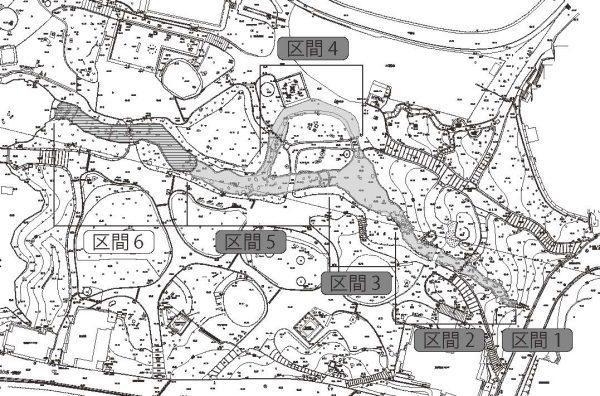
Source: Green Promotion Department of Kyoto City’s Construction Bureau,
“Preservation Management Plan for Place of Scenic Beauty, Maruyama Park”(2019)
Repairing the Stream Bottom
Among the various repairs we performed, this article focuses on the repair work done for the pond bottom, the park’s most prominent feature.
The process of pond bottom repair consisted broadly of 1.) debris removal, 2.) clearly indicating and recording repair areas, and 3.) pond bottom repair.
1.) Removing debris, cleaning the pond bottom
At the pond bottom, the area covered with fist-sized cobblestones was mixed with ground where gravel had been artificially sunken into the surface of the original ground and bedrock. Before surveying the area, we removed unnecessary trees and weeds that had grown into the accumulated soil and overshadowed the area. Plants were removed by their roots, but some roots reached down into cobblestones originally forming part of the pond bottom. Incautiously removing such roots could have destroyed the placement of these stones. We therefore performed our work with the utmost caution.


After removing accumulated soil from the pond bottom’s cobbled area, we washed it with water. Accumulated soil was removed and piled onto panels in lots of 30cm at a temporary storage facility. Water was drained using dedicated water drainage equipment.
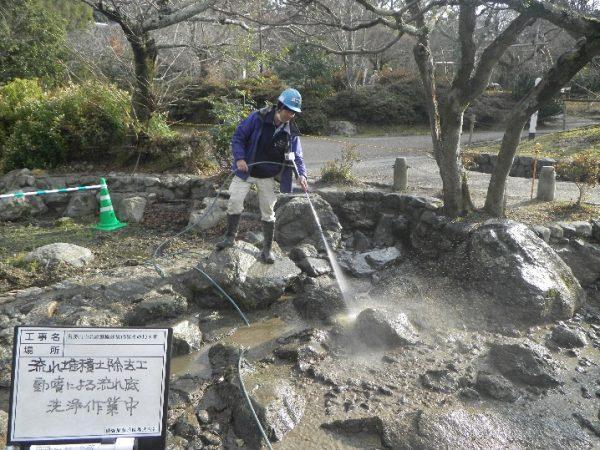
2.) Clearly indicating and recording repaired areas
This was the most unique process used for this work. Areas where cleaning was completed were clearly indicated by 1㎡ rectangular wooden frames set above them. These areas were then divided into three categories based upon the degree to which they were damaged. We designated Area A the area where cobbles stones were fully assembled, securely situated in mortar, and judged not to need repair. We designated Area B the area where cobblestones had come loose and only mortar remained. Finally, we designated Area C the area where both cobblestones and mortar had come loose so that the ground was exposed. Photographic records were taken for each of these areas.
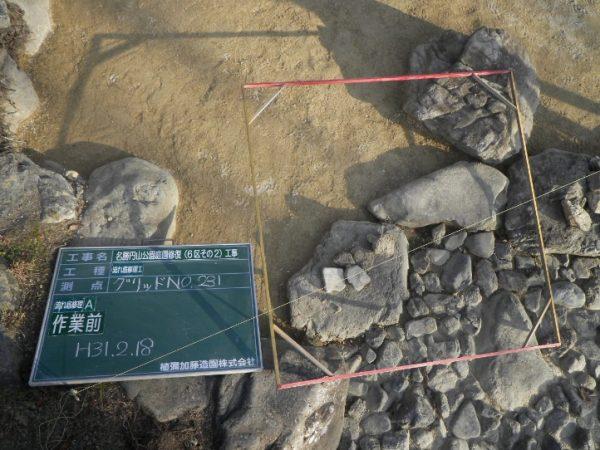
We also randomly selected five cobblestones with unique features from each 1㎡ area and recorded their positioning in that area. This helped us to stay faithful to the original design.
3.) Stream repair
Based on the indicated repair areas A, B, and C, as well as the area outside the repair area, we started repair work from the upstream section and moved downwards from there. Our aim was to take the pre-repair finishing as our basic guideline and allow the water, which had diminished since the stream’s construction, to spread over the entire stream. To determine the height of the mortar laid in each area, we used the oldest mortar at the stream bottom as our standard.
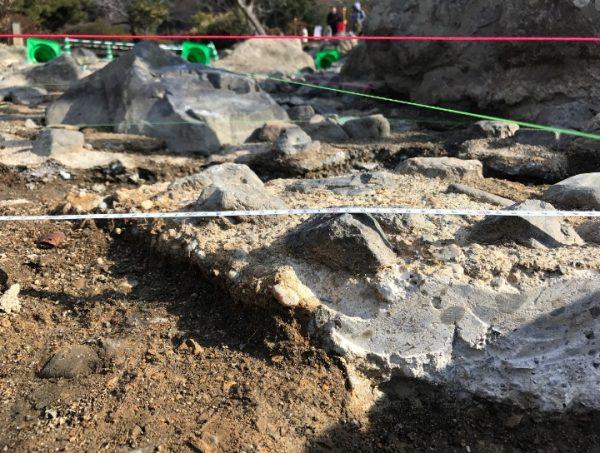
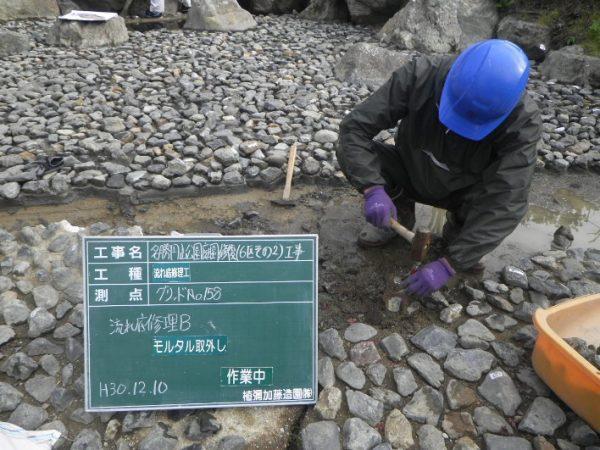
After removing the cobblestones and mortar, we removed ground weakened due to water seeping through the mortar. In areas where water flow likely had concentrated due to the uniform mortar thickness originally used for the stone pavement’s finishing, there were also places that had been seriously damaged. For this repair work, in areas requiring 7cm of mortar or more to be laid, we filled earth into places damaged by water and tamped it down to level out the ground before laying down mortar.
Next, our landscape gardeners installed mortar (3 parts sand, 1 part cement), applied adhesive, and laid down the cobblestones while making subtle adjustments to match the other stones in the surrounding area, both in terms of how they were packed together and their overall atmosphere. These gardeners also corrected and finished the fit between the cobblestones so that the direction and amount of water flowing in that area successfully spread over the entire stream.
After completing all repair processes, we created accurate record materials to convey the intentions behind the repair work in easy-to-understand terms.
In this way, the repairs performed for a garden that is designated a cultural property are done by contemporary garden specialists who have dedicated sufficient time into considering what construction methods to use. The work is then executed while taking records that make the work easy to convey to the present and the future.





